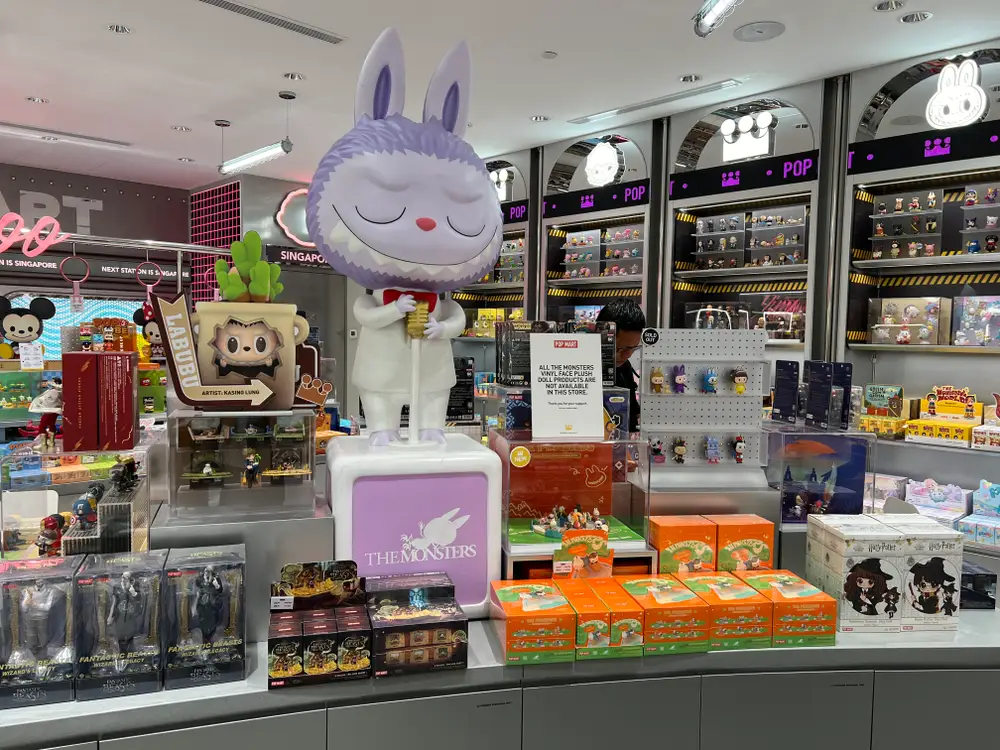A fluffy, $85 toy is taking Asia by storm and sparking legions of knockoffs. Inside the meteoric rise of Labubu.

Labubu toys are a hit in Singapore and beyond.
Grace Lee remembers the first time she saw a Labubu. It had rabbit-like ears and spikey teeth — and her immediate thought was that it was ugly.
But one day, the switch flipped, Lee, 36, said. After a colleague gifted her one in July, she started to look at it differently. “I don’t know why, but I started collecting them,” said the Singaporean, who works in operations.
“And the next thing I knew, I had, like, 12,” she said.
Lee is among the many who collect Labubu figurines, a toy that has taken Asia, and increasingly the West, by storm.
“Essentially, it’s appealing because it’s trendy, and trendy because it seems like something ‘everybody’ ─ at least in the target market’s circle of influence ─ wants,” said Joey Khong, a trends manager at market research firm Mintel.
The toy is explicitly for adults: Labubu’s product description reads, “Not suitable for persons under 15.”
Khong said the toys may be popular because they comfort tired corporate workers.
“Toys hold nostalgic value, offering comfort in an unpredictable world while also serving as affordable luxuries in a time of reduced disposable income due to rising costs,” she said.
The Labubu and Pop Mart phenomenon

Labubu dolls at the opening of a Pop Mart store in Bangkok.
Kasing Lung, a Hong Kong artist, created Labubu about a decade ago. Pop Mart, a Beijing-based toymaker, then developed “The Monsters,” a line of toys inspired by the character.
Lung did not respond to a request for comment from B-17.
According to Pop Mart’s website, Lung “created a fairy world in three picture books inspired by Nordic mythology, and populated it with magical characters both good and evil.”
“Among them, the most prominent one was LABUBU, a small monster with high, pointed ears and serrated teeth,” the website said. “Despite a mischievous look, LABUBU is kind-hearted and always wants to help, but often accidentally achieves the opposite.”
The larger plush dolls from “The Monsters” line are about 15 inches in height and cost about $85. Smaller dolls cost between $15 and $20.
According to Pop Mart’s 2024 interim report, released on August 20, “The Monsters” line generated sales of 6.3 billion Chinese yuan, or about $87 million, in the first half of the year. The company’s stock is up nearly 260% this year.
The toy is so immensely popular that it sells out minutes after it’s restocked. On a visit to a Pop Mart store in Singapore, a staff member told B-17 that Labubus are the most sellable figurines.
“It’s always out of stock,” said Tony Lee, who has worked in Pop Mart for four years. “Even when we replenish, within an hour — or less than an hour — it’s gone.”
He said Pop Mart typically restocks a few hundred figurines twice a week.
Pop Mart doesn’t announce when these restocks happen. Fans send updates to dedicated group chats on Telegram, and within less than 30 minutes of a restock, a “crazy line” forms outside the store, Lee said.
Knockoffs of the toy are rampant on Asian e-commerce platforms like Shopee, Lazada, and Taobao.
Celebrity endorsement played a huge role in Labubu’s success

The queue outside a Pop Mart outlet in Singapore during a restock of “The Monsters” figurines on a weekday afternoon.
Retail analysts largely attribute the Labubu craze to Lisa, one of the four singers from the hit K-pop band Blackpink, who posted the plush toy on her Instagram in April.
“I think the raging popularity of Labubu lies in its unique designs, emotional connection, exclusivity, and association with Lisa,” said Sory Park, a project manager at Chinese consumer research firm Daxue Consulting.
Juda Kanaprach, the cofounder of Southeast Asia-based market research firm Milieu Insight, said that the longtime popularity of collectible figures and designer toys in places like Japan, Hong Kong, and South Korea is now spreading to the rest of Asia. Pop Mart has 374 outlets in China alone.
“People are getting really into ‘art toys’ — they’re kind of a mix of art, fashion, and pop culture all rolled into one,” Kanaprach said.
“For a lot of millennials and Gen Zers, these aren’t just toys. They’re seen as little pieces of art or cool design items that look great in their homes. It’s like adding a bit of personality and style to their space, not just something to play with,” she added.
In a statement to B-17, a representative from Pop Mart said that Labubu has gained a strong global fan base.
“It’s become more than just a collectible—it’s a way for people to express themselves,” they said.
Collectors say Labubu is worth the snaking lines
When Sim Pei Yi heard from a group chat that Labubu toys were being restocked earlier this month, she rushed to a Singapore Pop Mart to join a snaking line with her colleague during lunchtime.
“There’s a bit of a ‘FOMO’ feeling,” said Sim, 31, who owns around six Labubu toys. “Everybody is getting Labubu. You will also want to have it.”

Ana Gonzales said she’s spent around $500 on her Labubu collection.
Elsewhere in Asia, Ana Gonzales, 38, started collecting Labubus after her friends talked about it in a group chat. Labubu keyrings are difficult to get in the Philippines, so she buys “blind boxes” — toys that aren’t labeled.
Gonzales estimates that she’s spent around $500 on her collection.
“For me, the real charm is in the blind boxes—not knowing what color you’ll get adds so much excitement,” Gonzales, a social media manager, said. “Opening a blind box after a long day or tiring week feels like unwrapping a gift to myself or a little reward.”
The love for Labubu toys has also spread to the US market. In September last year, Pop Mart opened its first permanent store in New Jersey. Now, there are 16 Pop Mart stores nationwide.
Tracy Hsu, a 42-year-old housewife in California, learned about Labubu through Lisa — her favorite member of Black Pink.
“When I first met Labubu, it made me really happy,” said Hsu. She has around 17 Labubu toys and said she spent over $10,000 on them. Once, she even camped outside a Pop Mart store for the latest drop.

Hsu once camped outside a mall in California to buy Labubu toys.
Her husband twice resorted to buying the toys from resellers at double the price. “I’m a little scared because there’s a lot of fake ones,” she said, adding that she requests to see receipts to ensure she’s getting the real deal.
Emotional comfort toys are on the rise everywhere
Labubu is not the first toy that has proven to be wildly popular with adults. Several other toymakers have leveraged adult loneliness to boost their brands.
Squishmallows — round, squishy toys with smiling faces — were the top-selling toy in the US and Canada in 2022, according to market research firm Circana.
This even led to the term “kidults” being coined for consumers of toys over the age of 12, who turn to stuffed animals to alleviate feelings of anxiety and loneliness.
For Grace Lee, the collector who owns 12 Labubus, collecting the toys not only brings her back to her childhood but also allows her to connect with a new community.
“Just hanging the toy on my bag opens conversations with people,” she said. “It’s quite a warm feeling.”






